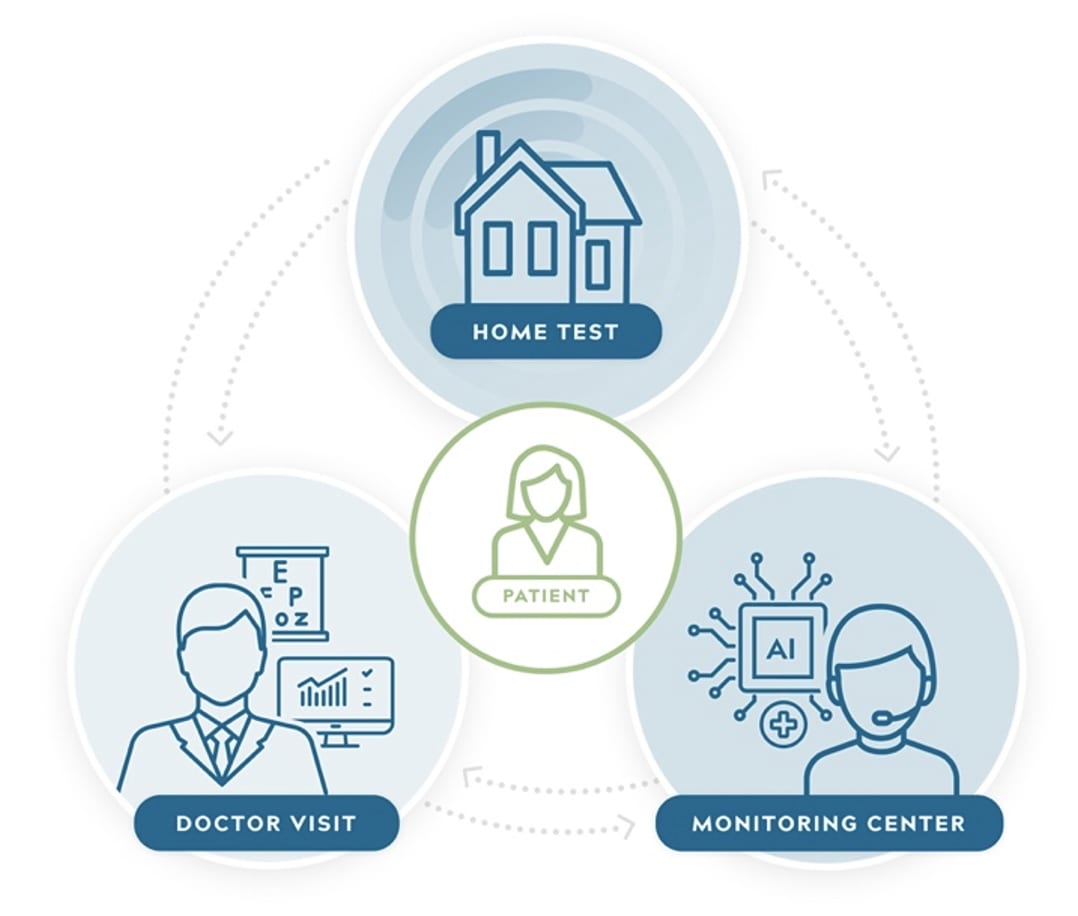Remote patient monitoring (RPM) is revolutionizing retinal care, providing earlier disease detection, improved patient outcomes, and optimized clinic efficiency. As digital technologies and artificial intelligence (AI) continue to evolve, their integration into ophthalmology practices is creating new opportunities for proactive management of conditions such as age-related macular degeneration (AMD), diabetic retinopathy (DR), and retinopathy of prematurity (ROP). While retina specialists evaluate these innovations, ophthalmic technicians and staff play a crucial role in the successful implementation and operation of RPM programs. This article explores the benefits of remote monitoring and provides key insights for ophthalmic staff to effectively support its adoption.
The Growing Role of Remote Patient Monitoring in Retina
RPM utilizes various digital tools to track retinal disease progression and identify changes requiring medical intervention. There are several solutions being marketed. Three key factors should be considered before adopting RPM platforms: 1. Patient outcomes from randomized controlled trials and real-world studies, 2. FDA 510k approval, and 3. Reimbursement.
Existing platforms include:
ForeseeHome AMD Monitoring Program (Notal Vision). A comprehensive service that includes a home-based preferential hyperacuity perimetry (PHP) test used to aid early detection of neovascular AMD (nAMD) conversion. The program received FDA clearance and Medicare coverage following the results of the AREDS2-HOME study, a randomized controlled trial that showed patients on the program saved over 5 letters of vision compared to those only using standard of care at the time of conversion to nAMD.1
myVisionTrack (mVT) Mobile App (Roche). An FDA registered Class 1 smartphone-based hyperacuity test for monitoring central visual function intended for the detection and characterization of metamorphopsia due to disease or treatment deterioration in patients with maculopathies. The app was validated in a Moorfields Eye Hospital study,2 but the promising results have yet to be validated in a randomized controlled trial.
Macustat (RemoniHealth). An FDA-registered multi-modal macular function scan accessible via any internet-connected device, allowing for remote monitoring of chronic retinal conditions. The results from 3 small-scale studies show strong correlations with in-office visual acuity examinations.3-5
ROP Telemonitoring. Wide-angle fundus photography platforms that enable remote screening and grading of ROP, as supported by American Academy of Ophthalmology and the American Academy of Pediatrics guidelines. Multiple studies have demonstrated the success of telemonitoring to identify referral/treatment warranted disease.6-8
AI-Driven DR Monitoring. Autonomous AI systems for staging DR, including FDA-cleared platforms like LumineticsCore (Digital Diagnostics, Inc.), EyeArt (Eyenuk, Inc.) and AEYE-DS (AEYE Health) are indicated for use with certain fundus cameras. The outcomes from the use of AI-based staging in DR have shown promising results.9,10
By incorporating these technologies, clinics may be able to reduce unnecessary in-office visits while ensuring patients receive timely care when intervention is needed.
What Ophthalmic Technicians and Staff Need to Know
The success of RPM programs relies on the collaboration between physicians and their support staff. Ophthalmic technicians and staff must be prepared to navigate new workflows, educate patients, and ensure seamless integration of remote monitoring into clinical practice.
1. Patient Selection, Education and Engagement
- Patient Selection – Staff is crucial in helping identify the appropriate patients for an RPM program. They can assist in reducing chair time by sharing pre-appointment education with flagged patients. Staff should be aware of basic criteria that makes the patient eligible, which simply includes their diagnosis. Over time, as staff gain more experience, they can also develop a better understanding of which patients may be more suitable for a particular RPM program.
- Setting Expectations – Patients should understand the purpose of remote monitoring, how it fits into their care plan, and the importance of consistent testing.
- Compliance Encouragement – Helping patients maintain adherence to prescribed monitoring schedules can improve early detection and outcomes.
2. Workflow Integration
- Referral and Enrollment – Technicians and administrative staff often handle patient referrals to remote monitoring programs. Understanding eligibility criteria and documentation requirements ensures smooth enrollment. Integration with a clinic’s EMR/EHR can facilitate this. For example, ForeseeHome can integrate with these systems to easily send an order or prescription for the service for qualified patients.
- Data Review and Alert Management – Clinics must establish protocols for monitoring alerts generated by RPM devices. Staff should be trained to recognize urgent alerts and facilitate timely physician review.
- Billing and Reimbursement – Remote monitoring services either have dedicated codes or may be reimbursable through CPT codes like those for remote physiologic monitoring (RPM). Administrative staff should be knowledgeable about billing processes to ensure proper reimbursement.
3. Collaboration With Monitoring Centers
We know one of the biggest challenges with RPM is patient adherence. The ALOFT study, which I co-authored, showed successful adherence to home-based testing—patients tested on average 5.2 times/week using the ForeseeHome device.11 In addition to the physician’s endorsement of the program, a dedicated monitoring center is key to this success. Such a center handles patient engagement, device shipping, data collection, technical support, and patient adherence to testing. Clinic staff serve as the primary liaison between the monitoring center and physicians, ensuring that significant findings are promptly addressed.
The Future of Remote Monitoring in Ophthalmology
The adoption of RPM in ophthalmology is expected to continue expanding, driven by advancements in AI, improved accessibility of digital tools, and growing reimbursement opportunities. Research is ongoing, with studies like DRCR Retina Network’s Protocol AO evaluating the clinical impact of home OCT-guided management for nAMD. Additionally, AI-powered diagnostic tools are likely to improve accuracy and efficiency in DR and ROP screenings.
By embracing these innovations and preparing support staff to navigate new workflows, eyecare practices can enhance patient care while optimizing clinical efficiency. For ophthalmic technicians and staff, staying informed about emerging technologies and best practices for RPM implementation will be essential in providing high-quality retinal care in the digital age. OP
References
1. Chew EY, Clemons TE, Bressler SB, et al. Randomized trial of the ForeseeHome monitoring device for early detection of neovascular age-related macular degeneration. Contemp Clin Trials. 2014;37(2):294-300. doi:10.1016/j.cct.2014.02.003
2. Korot E, Pontikos N, Drawnel FM, et al. Enablers and barriers to deployment of smartphone-based home vision monitoring in clinical practice settings. JAMA Ophthalmol. 2022;140(2):153-160. doi:10.1001/jamaophthalmol.2021.5269
3. Chen E, Mills M, Gallagher T, Ianchulev S, Habash R, Gentile RC. Remote patient monitoring of central retinal function with MACUSTAT: A multi-modal macular function scan. Digit Health. 2022;8:20552076221132105. Published 2022 Oct 17. doi:10.1177/20552076221132105
4. Chen EP, Mills M, Gallagher T, et al. Remote vision testing of central retinal acuity and comparison with clinic-based Snellen acuity testing in patients followed for retinal conditions. Digit Health. 2023;9:20552076231180727. Published 2023 Jun 4. doi:10.1177/20552076231180727
5. Charters L. In-home Accustat vision test: Equivalent results to in-office Snellen measurements. Ophthalmology Times Europe. October 12, 2023. Accessed April 25, 2025. https://europe.ophthalmologytimes.com/view/in-home-accustat-vision-test-equivalent-results-to-in-office-snellen-measurements
6. Lorenz B, Spasovska K, Elflein H, Schneider N. Wide-field digital imaging-based telemedicine for screening for acute retinopathy of prematurity (ROP). Six-year results of a multicentre field study. Graefes Arch Clin Exp Ophthalmol. 2009;247(9):1251-1262. doi:10.1007/s00417-009-1077-7
7. Dai S, Chow K, Vincent A. Efficacy of wide-field digital retinal imaging for retinopathy of prematurity screening. Clin Exp Ophthalmol. 2011;39(1):23-29. doi:10.1111/j.1442-9071.2010.02399.x
8. Wang SK, Callaway NF, Wallenstein MB, Henderson MT, Leng T, Moshfeghi DM. SUNDROP: Six years of screening for retinopathy of prematurity with telemedicine. Can J Ophthalmol. 2015;50(2):101-106. doi:10.1016/j.jcjo.2014.11.005
9. Abràmoff MD, Lou Y, Erginay A, et al. Improved automated detection of diabetic retinopathy on a publicly available dataset through integration of deep learning. Invest Ophthalmol Vis Sci. 2016;57(13):5200-5206. doi:10.1167/iovs.16-19964
10. Lim, J., et al. (2019). Artificial intelligence screening for diabetic retinopathy: Analysis from a pivotal multi-center prospective clinical trial. ARVO Imaging in the Eye Conference.
11. Mathai M, Reddy S, Elman MJ, et al. Analysis of the long-term visual outcomes of ForeseeHome remote telemonitoring: The ALOFT Study. Ophthalmol Retina. 2022;6(10):922-929. doi:10.1016/j.oret.2022.04.016











